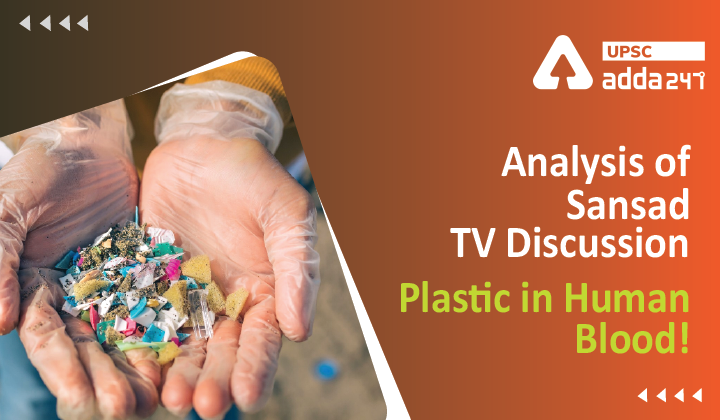Analysis Of Sansad TV Discussion
”Plastic in Human Blood!”
Relevance
”GS 3: Environmental Pollution & Degradation”
Context
- Recently, microplastic was detected for the first time in human blood.
- Micro plastics were found in nearly 80 per cent of samples tested by a group of researchers from the Netherlands.
- The overall concentration of plastic particles in the donor’s blood averaged 1.6 micrograms or one-millionth of a gram – the equivalent to one teaspoon of plastic per the amount of water in ten large bathtubs.
- The discovery is extremely significant as it shows that microplastic can travel around the body and may lodge in organs.
Background
- Plastic is one of the leading pollutants on the planet. Huge amounts of plastic waste are dumped from mountains to oceans.
- Previous research had found we inhale and ingest enough microscopic pieces of plastic to do many day-to-day activities. But until now, scientists didn’t know whether those particles were entering the bloodstream.
- In January last year, microplastics were found in fish and other seafood samples from the Sal Estuary in Goa.
About Microplastics
- Microplastics are tiny pieces of plastic less than 0.2 of an inch (5mm) in diameter.
- Microplastics are present in a variety of products, from cosmetics to synthetic clothing to plastic bags and bottles.
What did the researchers find?
- They found that half of the samples had PET (Polyethylene Terephthalate), which is used to make drinks bottles.
- Polystyrene, widely used in food packaging, was found in 36 per cent and polyethene, used in packaging films and bags, was found in 23 per cent of samples.
- The levels are low – 1.6 micrograms (1.6 millionths of a gram) in every millilitre of blood – but are enough to raise an alarm.
- Although the level is not much, but researchers only searched for a few plastic polymers. And plastic particles may be in different concentrations in different parts of the body.
Why it is a matter of great concern?
- Plastic is one of the leading pollutants on the planet. Huge amounts of plastic waste are dumped from mountains to oceans.
- Plastic particles were found in the blood of more than three-fourths (17 out of 22) of the Netherlands-based donors who participated in the study.
- Plastic particles can enter the body through your food and drink, the air we breathe – there are microscopic plastic bits flying around in the air – and even from the rain.
- Microplastics – or even smaller particles called nano plastics – could affect the brain, digestive system and other parts of the body. They Could help develop cancers.
What kind of plastic did the researchers find?
- Researchers analyzed subjects’ blood samples for traces of the presence of different polymers, which are the building blocks of plastics.
- Most prominent was polyethylene terephthalate (PET), a common type of plastic used in making drink bottles, food packaging and fabrics, and even lip gloss.
- The second most commonly found plastic in the samples: polystyrene, which is used to make a wide variety of common household products including disposable bowls, plates and food containers, and what we call styrofoam.
- The third most likely plastic found in subjects’ blood was polyethylene, a material regularly used in the production of paints, sandwich bags, shopping bags, plastic wrap and detergent bottles, and in toothpaste.
- Polypropylene, used in making food containers and rugs, was also found in subjects’ blood, but at concentrations too low for an accurate measurement.
Who is Responsible?
- Humans have produced 18.2 trillion pounds of plastics – the equivalent of 1 billion elephants – since large-scale plastic production began in the early 1950s.
- Nearly 80% of that plastic is now in landfills, researchers say. By 2050, another 26.5 trillion pounds will be produced worldwide.
- Plastic flowing into the world’s oceans, rivers and lakes will increase from 11 million metric tons in 2016 to 29 million metric tons annually in 2040, the equivalent of dumping 70 pounds of plastic waste along every foot of the world’s coastline, according to research from The Pew Charitable Trusts.
- We eat or breathe in about 2,000 tiny plastic particles each week, the World Wildlife Federation found in a 2019 study. Most are ingested from bottled water and tap water.
Microplastics: A problem that’s not going away until we stop using plastic
- Microplastics, a type of pollution, are literally everywhere, having been found from the bottom of the ocean to Mount Everest. We’ve known that fish have been ingesting them.
- More foods including fruits and vegetables may contain microplastics too.
- Previous research found that infants may ingest 10 times the amount of microplastics that adults do, based on a 2021 study comparing adult and infant feces. Babies could have higher microplastic exposures from bottles and baby toys, researchers suggest.
- Microplastics will continue to spread because plastic production is only increasing.



 TSPSC Group 1 Question Paper 2024, Downl...
TSPSC Group 1 Question Paper 2024, Downl...
 TSPSC Group 1 Answer key 2024 Out, Downl...
TSPSC Group 1 Answer key 2024 Out, Downl...
 UPSC Prelims 2024 Question Paper, Downlo...
UPSC Prelims 2024 Question Paper, Downlo...





